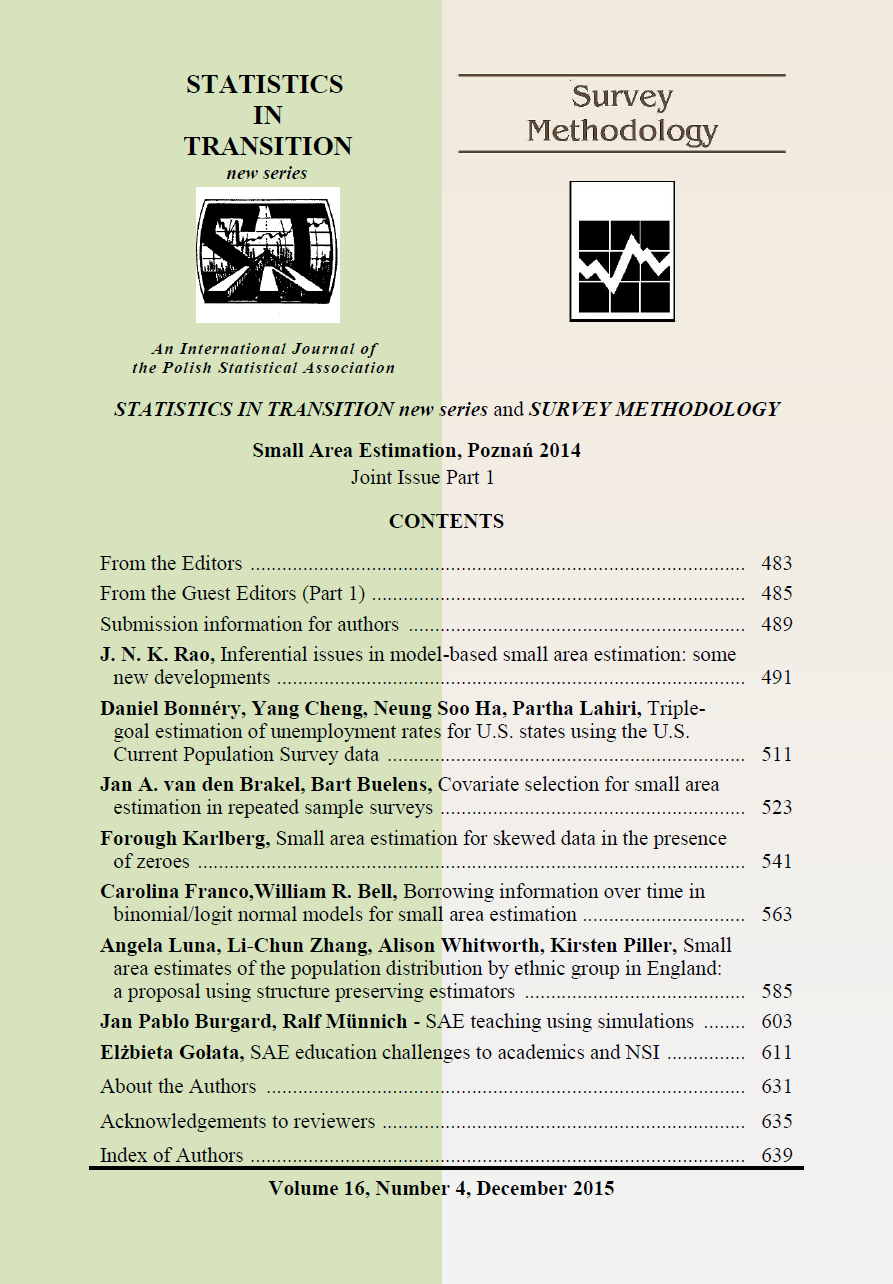ARTICLE
ABSTRACT
The increasing interest in applying small area estimation methods urges the needs for training in small area estimation. To better understand the behaviour of small area estimators in practice, simulations are a feasible way for evaluating and teaching properties of the estimators of interest. By designing such simulation studies, students gain a deeper understanding of small area estimation methods. Thus, we encourage to use appropriate simulations as an additional interactive tool in teaching small area estimation methods.
KEYWORDS
small area estimation, teaching, simulations, design-based simulations, model-based simulations.
REFERENCES
ALFIERI, L., BROOKS, P. J., ALDRICH, N. J., TENENBAUM, H. R., (2011).Does discovery- based instruction enhance learning? Journal of Educational Psychology, 103(1): 1.
BATTESE, G. E., HARTER, R. M., FULLER, W. A., (1988). An error components model for prediction of county crop areas using survey and satellite data. Journal of the American Statistical Association, 83(401):28–36.
BRUNER, J. S., (1961). The act of discovery. Harvard educational review.
BURGARD, J. P.(2013). Evaluation of Small Area Techniques for Applications in Official Statistics. PhD Dissertation, Universität Trier.
COCHRAN, W. G., (2007). Sampling Techniques. Wiley seriesin probability and mathematical statistics: Applied probability and statistics.John Wiley& Sons,New York, ISBN 9780471162407.
DELMAS, R. C., GARFIELD, J., CHANCE, B., (1999). A model of classroom research in action: Developing simulation activities to improve students’ statistical reasoning. Journal of Statistics Education, 7(3).
HESTERBERG, T. C., (1998). Simulation and bootstrapping for teaching statistics. In American Statistical Association Proceedings of the Section on Statistical Education, pages 44–52.
KALSBEEK, W., (1996). The computer program called sample: A teaching tool to demonstrate some basic concepts of sampling (version 1.01). In American Statistical Association Proceedings of the Section on Statistical Education,Volume 103.
KIRSCHNER, P. A., SWELLER, J., CLARK, R. E., (2006). Why minimal guidance during instruction does not work: An analysis of the failure of constructivist, discovery, problem-based, experiential, and inquiry-based teaching. Educational psychologist, 41(2): 75–86.
MAYER, R. E., (2004). Should There Be a Three-Strikes Rule Against Pure Discovery Learning? The Case for Guided Methods of Instruction. American Psychologist, 59(1): 14–19, Jan. 2004. ISSN 0003066X. doi: 10.1037/0003-066X.59.1.14.
MCKENZIE J. D., (1992). Why aren’t computers used more in our courses. In Proceedings of the Section on Statistical Education, pages 12–17. The Association.
MILLS, J. D., (2003). A theoretical framework for teaching statistics. Teaching Statistics, 25 (2): 56–58.
MÜNNICH, R., (2014). Small area applications: some remarks from a design based view. SAE 2014-Conference on Small Area Estimation in Poznan,http://sae2014.ue.poznan.pl/presentations/SAE2014_Ralf_Munnich_c330a31c0a.pdf.
MÜNNICH, R. T., BURGARD, J. P., VOGT, M., (2013). Small Area-Statistik:Methoden und Anwendungen. AStA Wirtschafts- und Sozialstatistisches Archiv, 6(3): 149–191.
PFEFFERMANN, D., (2006). Invited discussion of paper by J. Jiang and P.Lahiri: Mixed model prediction and small area estimation. TEST, 15:65–72, URL http:// eprints.soton.ac.uk/38527/.
RAO, J. N. K., (2003). Small Area Estimation. Wiley series in survey methodology. John Wiley and Sons, New York.
SÄRNDAL, C. E., SWENSSON, B., WRETMAN J., (1992). Model Assisted Survey Sampling. Springer, New York.
SHEN, W., LOUIS, T., (1998). Triple-goal estimates in two-stage hierarchical models. Journal of the Royal Statistical Society: Series B (Statistical Methodology), 60(2): 455–471
